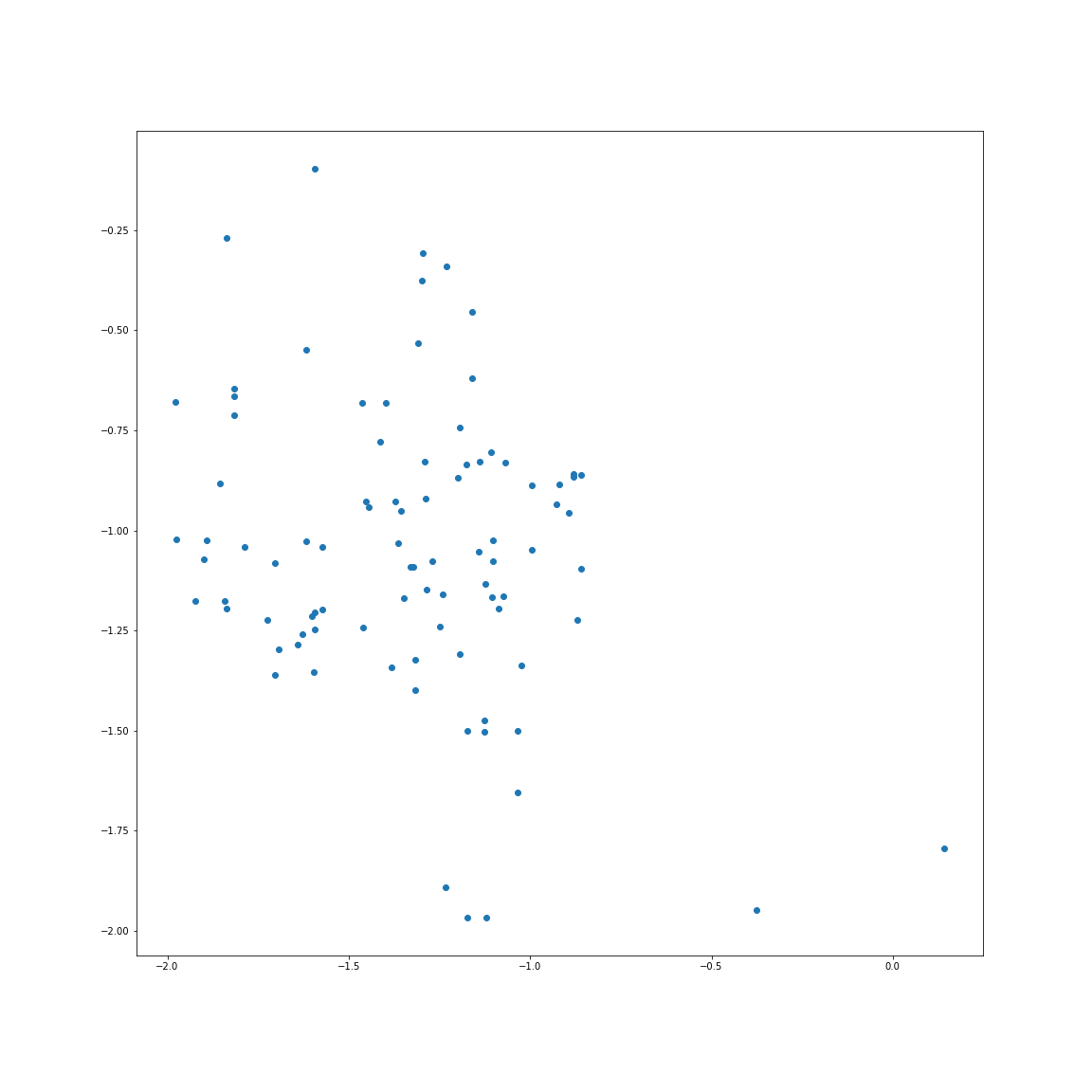
pymoo包NSGA2算法实现多目标遗传算法调参详细说明
n_var定义的是待求解的XXX变量数量n_obj定义的是待求解fff问题数量定义的是约束条件的数量xl定义的是待求解的XXX参数的下限xu定义的是待求解的XXX参数的上限f1,f2定义问题g1,g2定义约束条件。
·
pymoo包NSGA2算法实现多目标遗传算法调参详细说明
1.定义待求解问题
1.0定义问题的参数说明
-
1.0.0 求解问题必须设置在
def _evaluate(self, x, out, *args, **kwargs)函数中 -
1.0.1 问题必须用 out[“F”] = [f1, f2] 包裹起来
-
1.0.2 约束条件也必须用 out[“G”] = [g3] 包裹起来
-
1.0.3
def __init__(self):里需要定义以下参数 n_var定义的是待求解的 X X X变量数量n_obj定义的是待求解 f f f 问题数量n_ieq_constr定义的是约束条件的数量xl定义的是待求解的 X X X参数的下限xu定义的是待求解的 X X X参数的上限f1,f2定义问题g1,g2定义约束条件-
1.0.4 约束条件的g以不等式形式写明 会按照小于等于0 进行选择
import numpy as np
from pymoo.core.problem import ElementwiseProblem
class MyProblem(ElementwiseProblem):
def __init__(self):
super().__init__(n_var=2, # X 变量数量
n_obj=2, # f 问题数
n_ieq_constr=1,# g 约束条件数量
xl=np.array([-2,-2]), # X 自变量下限
xu=np.array([2,2])# X 自变量上限
)
def _evaluate(self, x, out, *args, **kwargs):
# 待求解函数
f1 = np.cos(x[0]+x[1]) #100 * (x[0]**2 + x[1]**2)
f2 = np.sin(x[0]+x[1]) #(x[0]-1)**2 + x[1]**2
# f3 = (abs(x[0])<0.3)+(abs(x[1])<0.5)
# 约束条件会选择 <= 0 的选择
# g1 = 2*(x[0]-0.1) * (x[0]-0.9) / 0.18
# g2 = - 20*(x[0]-0.4) * (x[0]-0.6) / 4.8
# g3 = ((x[0]**2)<0.5)+((x[1]**2)>0.3)
g3 = x[0]-0.7 #+(abs(x[1])<0.3)
out["F"] = [f1, f2] #待求解问题
#out["G"] = [g1, g2,g3] #约束条件
out["G"] = [g3] #约束条件
problem = MyProblem()
2.调用NSGA2的算法包设置参数
2.1 NSGA2函数的参数设置
pop_sizez种群数量n_offsprings每代的数量sampling#抽样设置crossove()交叉配对设置-
prob交叉配对的概率设置
-
eta
mutation()变异译概率-
prob是变异的概率设置
-
eta
eliminate_duplicates我们启用重复检查(“eliminate_duplicates=True”),确保交配产生的后代在设计空间值方面与自身和现有种群不同。
from pymoo.algorithms.moo.nsga2 import NSGA2
from pymoo.operators.crossover.sbx import SBX
from pymoo.operators.mutation.pm import PM
from pymoo.operators.sampling.rnd import FloatRandomSampling,IntegerRandomSampling,BinaryRandomSampling
algorithm = NSGA2(
pop_size=90, # z种群数量
n_offsprings=100, # 每代的数量
sampling= FloatRandomSampling(), #抽样设置
#交叉配对
crossover=SBX(prob=0.9 #交叉配对概率
, eta=15), #配对效率
#变异
mutation=PM(prob=0.8 #编译概率
,eta=20),# 配对效率
eliminate_duplicates=True
)
3.定义迭代次数90次
from pymoo.termination import get_termination
termination = get_termination("n_gen", 90)
4.求解最帕累托最优解集的参数x向量
from pymoo.optimize import minimize
res = minimize(problem,
algorithm,
termination,
seed=1,
save_history=True,
verbose=True)
X = res.X # 求解出来的参数
F = res.F # 帕累托最优解集
4.2 查看输出的X的解
array([[-1.22983903, -0.3408983 ],
[-1.17312926, -1.9683635 ],
[-1.62815244, -1.25867184],
[-1.59459202, -1.24720921],
[-0.85812605, -0.86104326],
[ 0.14217774, -1.79408273],
[-1.16038493, -0.45298884],
[-1.30857014, -0.53215836],
[-0.99480251, -1.0484723 ],
[-1.17506923, -0.83512127],
[-1.12330204, -1.13340585],
[-1.02395611, -1.33764674],
[-0.99658648, -0.88776711],
[-0.87963539, -0.86581268],
[-1.59330301, -0.09593218],
[-1.89860429, -1.07240541],
[-0.92025241, -0.88515559],
[-1.89221588, -1.02590525],
[-1.15977198, -0.61984559],
[-1.23391136, -1.89214062],
[-1.08575639, -1.1960931 ],
[-1.8422881 , -1.17730121],
[-1.97907088, -0.67847822],
[-1.19339619, -1.30837703],
[-1.81657534, -0.6468284 ],
[-1.34872892, -1.1691978 ],
[-1.70461135, -1.08101794],
[-1.28766298, -0.92085304],
[-1.10488217, -1.16702018],
[-1.45199598, -0.92807938],
[-1.83785271, -0.26933177],
[-1.10292853, -1.0760453 ],
[-1.97460715, -1.02344251],
[-1.92346673, -1.17730121],
[-1.35716933, -0.9513154 ],
[-1.07370789, -1.16339584],
[-1.61844778, -0.54832033],
[-1.69262569, -1.29666833],
[-1.1205858 , -1.9683635 ],
[-1.32886108, -1.09105746],
[-0.87963539, -0.85896725],
[-1.17319829, -1.50153054],
[-1.63954555, -1.28599005],
[-0.92662448, -0.93538073],
[-1.29072744, -0.82715754],
[-1.72496415, -1.22313643],
[-1.70410919, -1.36171497],
[-1.57300848, -1.04123091],
[-1.81522276, -0.66364657],
[-1.28643454, -1.14856238],
[-1.13870379, -0.8286136 ],
[-1.60254074, -1.21320856],
[-1.3972806 , -0.68146238],
[-1.37242908, -0.92807938],
[-1.29950364, -0.37689045],
[-1.32237812, -1.09105746],
[-1.59549137, -1.35399596],
[-0.86920703, -1.22313643],
[-1.38180886, -1.34157915],
[-1.46024398, -1.24232167],
[-1.12485534, -1.47579521],
[-1.24917941, -1.2408934 ],
[-1.6174287 , -1.02798238],
[-1.46214609, -0.68146238],
[-0.89315598, -0.95504252],
[-1.2693953 , -1.07649403],
[-1.31640451, -1.32237493],
[-1.2414329 , -1.15952844],
[-1.10828403, -0.80474544],
[-1.06864911, -0.83165391],
[-1.83785271, -1.1960931 ],
[-1.03382957, -1.50125804],
[-1.81678927, -0.71106355],
[-1.12485534, -1.50226124],
[-1.14170746, -1.05251568],
[-0.37583973, -1.94856256],
[-1.19888652, -0.86892885],
[-1.44462396, -0.94172587],
[-1.57293402, -1.19861388],
[-1.7873066 , -1.04123091],
[-1.19339619, -0.74337764],
[-1.41439116, -0.77744839],
[-1.03394747, -1.65557748],
[-1.29621172, -0.30606688],
[-0.85812605, -1.09549174],
[-1.31640451, -1.39906326],
[-1.36337969, -1.03256822],
[-1.59459202, -1.20585082],
[-1.10292853, -1.02523266],
[-1.85491578, -0.88327578]])
5.帕累托最优解集的X向量参数最优解集分布
import matplotlib.pyplot as plt
plt.figure(figsize=(16,16))
plt.scatter(X[:,0],X[:,-1])

6.画出帕累托前沿
import matplotlib.pyplot as plt
plt.figure(figsize=(16,9))
plt.scatter(F[:,0],F[:,-1])
plt.savefig("NSGA2demo帕累托前沿.png")


开放原子开发者工作坊旨在鼓励更多人参与开源活动,与志同道合的开发者们相互交流开发经验、分享开发心得、获取前沿技术趋势。工作坊有多种形式的开发者活动,如meetup、训练营等,主打技术交流,干货满满,真诚地邀请各位开发者共同参与!
更多推荐
 已为社区贡献2条内容
已为社区贡献2条内容





所有评论(0)